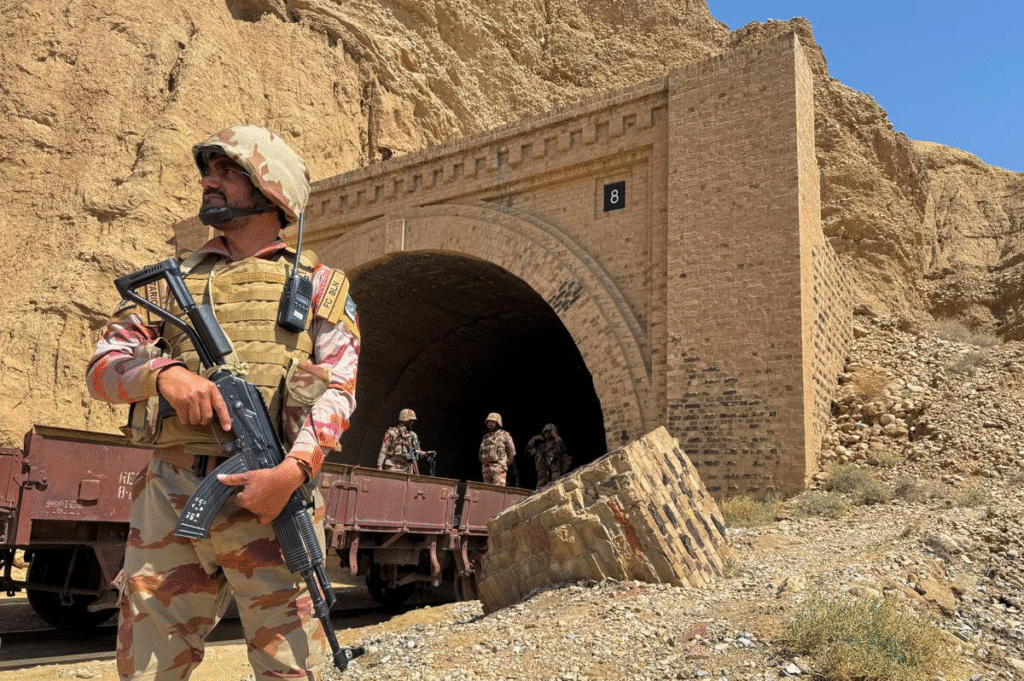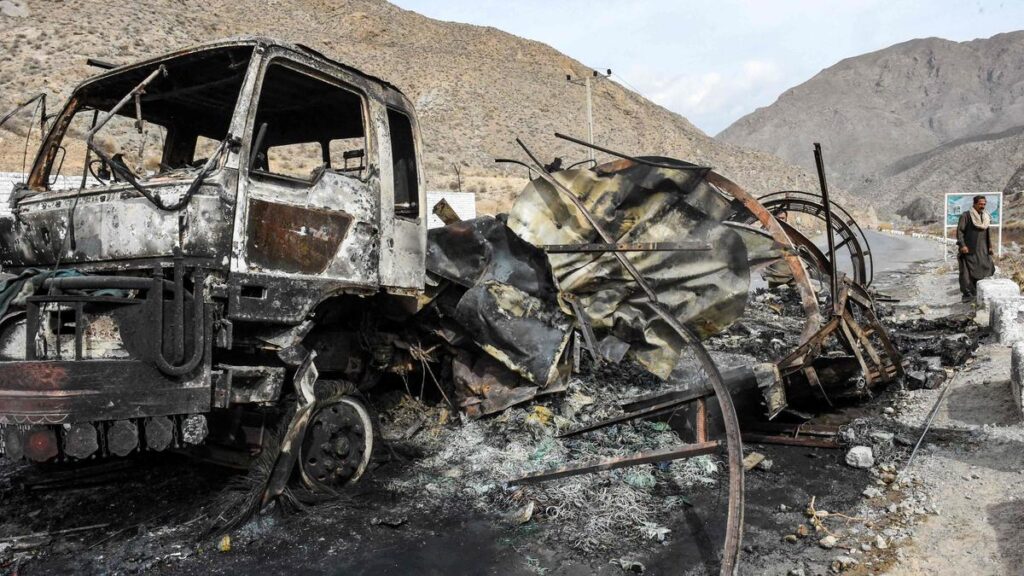
The Attack: A Deadly Blast in the Heart of Balochistan
On a seemingly routine day in the mountainous region of Balochistan, Pakistan, an event of harrowing significance unfolded. An improvised explosive device (IED) detonated in the Bolan district, hitting a military convoy and sending shockwaves across the nation. The blast killed multiple soldiers and left many others injured, as the devastation was caught on camera by the attackers themselves.
This explosion, which claimed lives and created chaos in its wake, is not just a random act of violence but a well-executed assault that signals much more. The Balochistan Liberation Army (BLA), a separatist militant group, immediately took responsibility for the attack, sharing footage online, adding an element of psychological warfare to the tragic event. The public release of such images speaks to a broader strategy aimed at inciting fear, spreading their message, and asserting control over the narrative of the region’s troubled history.
The Balochistan Liberation Army: A Seemingly Unstoppable Force
The BLA is no stranger to violence, and their presence in Balochistan has become a source of tension and conflict for years. This militant group has been actively seeking independence for the Baloch people, demanding an end to Pakistan’s control over the province. They argue that the region’s vast natural resources are being exploited by the central government, leaving the indigenous population marginalized, impoverished, and disenfranchised.
For decades, Balochistan has been embroiled in a struggle between separatists and the Pakistani government, with various insurgent groups rising to prominence in opposition to the state. The BLA, in particular, has gained notoriety for its bold attacks on security forces and government installations. Its operations are marked by a combination of traditional guerrilla tactics and more sophisticated, strategic operations such as this IED attack, which reflects the group’s growing capabilities.
Balochistan’s Socioeconomic Struggles: Why the Discontent?
At the heart of the conflict is the severe underdevelopment of Balochistan. Despite its vast natural wealth, including oil, gas, and minerals, the region remains one of Pakistan’s poorest. There is a widespread perception that the central government has failed to invest in the region’s infrastructure, education, and healthcare. Balochistan’s people, particularly in rural areas, live in conditions far worse than those in other parts of the country, leading to a sense of abandonment and frustration.
Furthermore, the Baloch have long been dissatisfied with their political marginalization. While Pakistan’s powerful military and civilian elite dominate the national stage, the Baloch have struggled for a meaningful voice in Pakistan’s governance. Over the years, this disenfranchisement has led to the rise of a separatist movement, which views the Pakistani state as an occupying force that disregards the rights of the Baloch people.
The Rise of Separatist Movements in Balochistan
The roots of Baloch separatism can be traced back to the early days of Pakistan’s formation. The Baloch people have a long history of autonomy and self-rule, which was severely curtailed after Pakistan gained independence. Over time, the failure of successive governments to address the region’s grievances led to the emergence of various separatist movements, including the BLA. These groups have repeatedly called for an independent Balochistan, citing cultural, political, and economic suppression at the hands of the central government.
The BLA has evolved over the years, initially operating as a smaller guerrilla faction before growing into a formidable force capable of carrying out high-profile attacks. The group has increasingly used sophisticated technology and media strategies, including the use of digital platforms to share footage of their attacks. This tactic not only aims to spread fear but also to rally support from Baloch nationalists, both within Pakistan and among the diaspora abroad.
The Psychological Impact of Publicly Released Footage
Perhaps one of the most disturbing aspects of this attack is the BLA’s decision to publicly release the footage of the explosion. In an age where information travels fast, and social media amplifies every story, the video served as a tool for propaganda. The intention was clear: the BLA wanted the world to see their power, their ability to strike with precision, and their determination to continue their campaign for an independent Balochistan.
The release of such footage serves as a form of psychological warfare. The attack itself is devastating enough, but the public dissemination of its aftermath serves to further instill fear and uncertainty. For the Pakistani public, the video is a reminder that the insurgency is not only alive but growing in strength. This serves to destabilize the already volatile situation in the region, further polarizing opinions and strengthening the resolve of separatist forces.
For the Pakistani government and military, this presents a complex challenge. How do they respond to a group that not only uses military force but also capitalizes on digital media to control the narrative? In an age where public opinion and social media play such a crucial role, this new form of warfare cannot be ignored.
The Role of the Military: More Force, or a New Approach?
In the aftermath of the attack, Pakistan’s military has vowed to retaliate, promising to intensify operations against insurgent groups in Balochistan. However, this approach has come under criticism from various quarters. Some argue that increasing military force will only exacerbate the existing tensions, leading to more violence and suffering for the civilian population. There is also a growing belief that military solutions alone cannot resolve the underlying political and social issues that drive the conflict.
In recent years, Pakistan’s approach to Balochistan has been a mixture of military action and sporadic attempts at dialogue. However, the success of these efforts has been limited. While the military has been able to suppress insurgent groups temporarily, it has not been able to provide a lasting solution to the grievances of the Baloch people.
For peace to be achieved, many experts argue that the government must focus on addressing the root causes of the insurgency. This would involve engaging in a meaningful political dialogue with Baloch leaders, addressing economic disparities, and offering more autonomy to the province. Without such reforms, the cycle of violence is likely to continue.
Balochistan and Its Strategic Importance
Balochistan is not just a flashpoint for internal conflict; it also holds significant geopolitical importance. The region borders Afghanistan and Iran and is home to the strategically crucial Gwadar Port, a key asset in China’s Belt and Road Initiative (BRI). The port, which is expected to become a major trade hub, is at the heart of China-Pakistan Economic Corridor (CPEC) projects, which aim to connect Gwadar to China’s western region.
Given its economic significance, any instability in Balochistan has the potential to affect broader regional security and economic interests. For China, the BRI represents a cornerstone of its global strategy, and disruptions in the region could have far-reaching implications for its economic plans. For Pakistan, the stability of Balochistan is crucial not only for domestic security but also for maintaining good relations with its key ally, China.
The presence of foreign interests, particularly China’s growing role in Balochistan, adds a layer of complexity to the situation. While the Pakistani government views the BLA as a threat to national security, separatist groups see the increasing foreign influence as a form of external domination over the region’s resources. This has led to further resentment among the local population, complicating efforts for peace.
The Human Cost: The Forgotten People of Balochistan
While the focus of the media often remains on the violence and political dynamics, the true human cost of the conflict is borne by the people of Balochistan. Both soldiers and civilians are caught in the crossfire, with families on both sides suffering the consequences of the ongoing violence.
For the Baloch civilians, the situation is dire. Despite the region’s rich resources, most Baloch people live in poverty, lacking access to basic services such as education, healthcare, and clean water. Many of them feel trapped in a cycle of violence, where every day brings new challenges. The presence of the military only heightens their sense of insecurity, as security operations often involve curfews, blockades, and raids on homes, further infringing on their rights and freedoms.
The Pakistani military, while focused on securing the region, has been criticized for its heavy-handed tactics. The strategy of using force to quell insurgency has only alienated the civilian population, pushing more people toward separatist groups like the BLA.
Looking to the Future: Can Balochistan Find Peace?
The road to peace in Balochistan is fraught with challenges, and the recent IED attack is a painful reminder of the conflict’s deep-rooted complexities. While the Pakistani military’s actions may bring short-term stability, they will not address the underlying grievances that fuel the insurgency. The only way forward is through meaningful dialogue, economic development, and political reforms that give the Baloch people a sense of ownership over their future.
Balochistan’s future remains uncertain, and while some fear the escalation of violence, others remain hopeful that a peaceful resolution can be reached. However, for any lasting peace to take hold, it will require the collective efforts of the Pakistani government, Baloch leaders, and the international community to ensure that the voices of the people of Balochistan are heard and their rights are respected.

